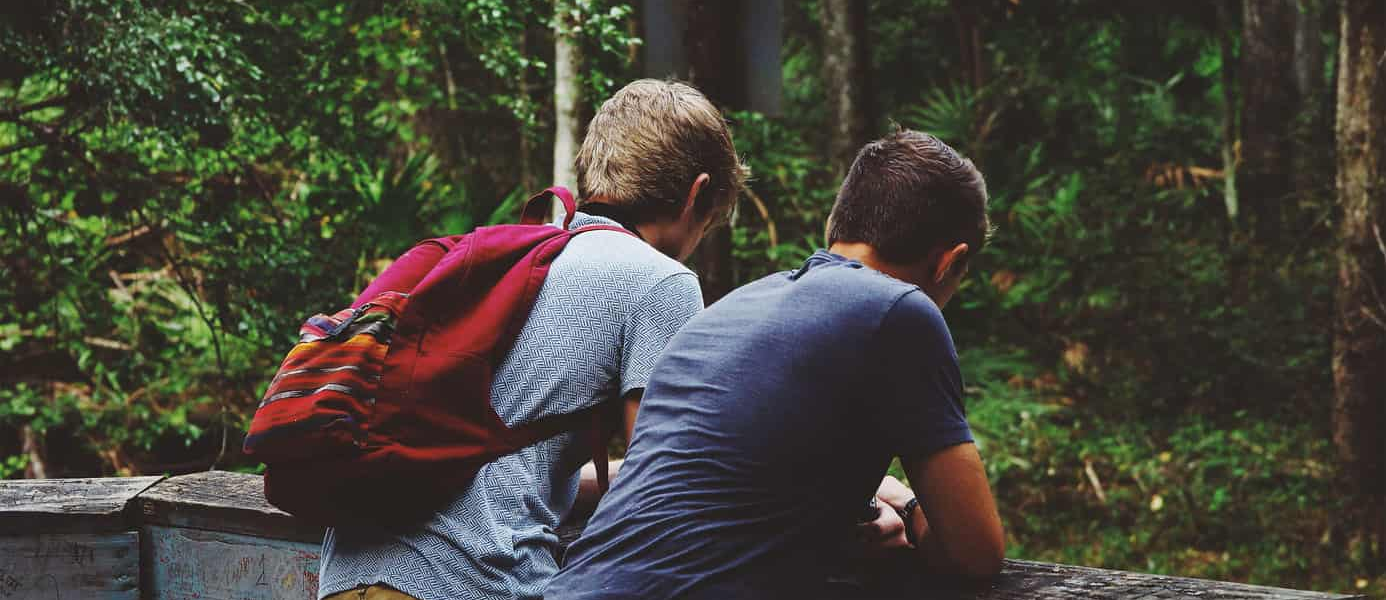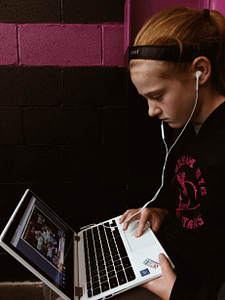Back in the day…
It was just after 3 o’clock on a warm fall day, and Jeff and Mike* were a bit jumpy on the bus ride home. They tried not to look at each other, wondering if someone would know. Getting off where they were both supposed to get off, they raced home to drop backpacks and pick up bicycles.
They had selected the meeting place last week. It was strategic; they didn’t want to be somewhere they shouldn’t be and get busted for their presence, but they didn’t want to be somewhere that someone could see what they were going to do. It was behind the house at the end of the block, down the path leading to the pond that wasn’t crowded on weekdays. It’s where they would build forts when they were younger. But they weren’t little kids building forts anymore. They were sophomores in high school. And Jeff had found the stash of adult magazines that his uncle ‘hid’ under the guest bed. He wouldn’t miss just one…would he?
Jeff snuck it out of his backpack after making sure no one was coming, and then they flipped through the pages with eyes wide open. They’d heard about such images and assumed “everyone else” had seen them, but this was their first time with their hands on a copy of Playboy.
After a few uncomfortable minutes, Mike assumed responsibility for destroying the evidence. After all, Jeff had borne the risk of obtaining and transporting the magazine, so it was only fair that his buddy had to get it to the dumpster behind the convenience store without being seen.
*Names and identifying details have been altered in this real-life story.
There was a day when sneaking a peek at pornography took careful planning, physical materials, and the destruction of evidence.
Teenagers weren’t allowed into adult bookstores and would not want to be caught in “that section” of a video rental store. Acquiring pornographic content came with risk and embarrassment, and the act of viewing it was most certainly done in secret, physically far away from parents and other authority figures.
Then the Internet moved into the neighborhood.
When the Internet became common in homes in the ‘90s with dial-up service, it ushered in an era of seemingly private and relatively instant access to pornography. There remained constraints, such as the limited bandwidth of those early connections and the placement of the household computer (typically in a highly visible shared area of the home, such as the family room), but the Internet connection did usher in a new and different way to view pornography.
Perhaps the most significant development, not fully realized at the outset, was that the Internet changed what was available by offering up access to infinite images instead of the finite ones offered in print or on a VHS tape. Our brains are wired to seek novelty, and the Internet makes that easy. However, even this shift was only a small bend toward the dramatic turn that was about to take place.
And the smartphone changed everything.
Since the release of the first iPhone in 2007, porn is seen in secret silos within seconds on handheld screens. And access isn’t limited to adults. Within a few years of the iPhone’s launch, smartphone adoption was nearly universal. In 2012, only 23% of teenagers had a smartphone; by 2018, it was 95%. This device that is in the hands of almost all teenagers provides effortless access to anything and everything online.
According to one study, “50% of 11- to 13-year-olds, 65% of 14- to 15-year-olds, and 78% of 16- to 17-year-olds reported having seen pornography in some way,” whether it was on purpose or by accident. And according to Fight the New Drug—a non-religious and non-legislative anti-porn organization—some sources indicate that the average age children are exposed to pornography is 11 years old, and some are as young as 8.
“Smartphones offer new and dynamic means of accessing and distributing pornography. Apps and text are an increasingly popular option, especially among teens and young adults. While just 12 percent of adults 25 and older view porn mostly on their phone, teens and young adults are three times more likely to do so (38%),” according to The Porn Phenomenon by Barna.
Porn is now in the pocket of every human with a smartphone, and it only takes one quick click to clear browser history and erase the evidence. The world has changed, and pornography—hardcore porn—is now at the fingertips of everyone with a smartphone.
Teenagers and curiosity have not changed, but their environment has.
“Today’s pornography is so intense compared to Playboy magazine in the ‘70s,” said Dr. Jimmy Myers, a certified sexual addiction counselor.
From the perspective of brain stimulation, there is a massive difference between the racy-but-static still images published in print and the endless high-production and high-definition porn videos available online. If pornography were a drug, the product on the market today is far more addictive and accessible than what was found even 20 years ago on slow dial-up Internet access.
Teenage curiosity certainly predates the Internet. Nonetheless, before the dawn of the search engine, questions about sexuality had to be answered—often with some embarrassment—by another human or researched in a book or magazine.
The easily accessible information sources of decades past—when there were no conversations about or need for apps focused on Internet safety for kids—are nothing compared to where online searches take the curious today. According to a 2018 The New York Times Magazine article, What Teenagers Are Learning From Online Porn:
“Imagine that you are a 14-year-old today. A friend might show you a short porn clip on his phone during the bus ride to school or after soccer practice. A pornographic GIF appears on Snapchat. Or you mistype the word ‘fishing’ and end up with a bunch of links to ‘fisting’ videos. Like most 14-year-olds, you haven’t had sex, but you’re curious, so maybe you start searching and land on one of the many porn sites that work much like YouTube … Or you find Pornhub, the most popular of the group, with 80 million visitors a day and more traffic than Pinterest, Tumblr or PayPal. The mainstream websites aren’t verifying your age, and your phone allows you to watch porn away from the scrutinizing eyes of adults. If you still have parental-control filters, you probably have ways around them.”
What one could discover if they were able to get their hands on a magazine, book, or video in decades past was a far cry from what’s accessible on every device with an Internet connection today.
“It’s not innocent. It’s not ‘boys will be boys.’ Those boys become men, and everything they ever learned about sex will be from pornography,” Dr. Myers also said.
These lessons learned are destructive and damaging; they have permanent effects. Teenagers are assuming that what they see online, which would typically be considered hardcore porn, unrealistic photoshopped, and fake, is what real, healthy intimacy looks like.
According to What Teenagers Are Learning From Online Porn: “These images confound many teenagers about the kinds of sex they want or think they should have. In part, that’s because they aren’t always sure what is fake and what is real in porn. Though some told me that porn was fantasy or exaggerated, others said that porn wasn’t real only insofar as it wasn’t typically two lovers having sex on film. Some of those same teenagers assumed the portrayal of how sex and pleasure worked was largely accurate.”
The world has changed, so how we respond as parents needs to change, too. It now includes talking about Internet safety for kids.
With the introduction of the smartphone, the proliferation of high-definition videos, and the emergence of ‘darker’ themes, the risks posed by pornography are greater than they have ever been, and certainly more so than those posed by the old Playboy magazine. No one wakes up and decides to become addicted to hardcore porn, and most kids don’t even go looking for it. However, their likelihood of being exposed to it is at an all-time high.
Technology and pornography have changed, increasing the risk of online danger for children and necessitating that parenting approaches change. Most parents would agree that, in 2020, one of these changes includes intentionally parenting in the digital world, just like they would in the real one. This wasn’t the case before having the Internet in the palm of almost every hand—including the hands of children—was considered normal. Parents now have a common language for talking about Internet safety for kids, and there are apps for choosing what videos and content your child can see. As new technologies evolve, parents have the opportunity to guide their children in learning how to use them wisely.
It’s time to leverage technology to solve a problem that technology created. And we want to help.
As parents navigate the joys and challenges of raising children in a tech-saturated age, we are here to partner with you to protect those you love most by prioritizing Internet safety for kids. We have a tool that can block pornographic images in real-time using artificial intelligence on nearly every device, preventing inappropriate content from reaching the screens of the smartphones, tablets, and computers it protects.
Will you join us in changing the world, one device at a time?
Sign up for a free trial of Canopy and stay connected with our newsletter below!








